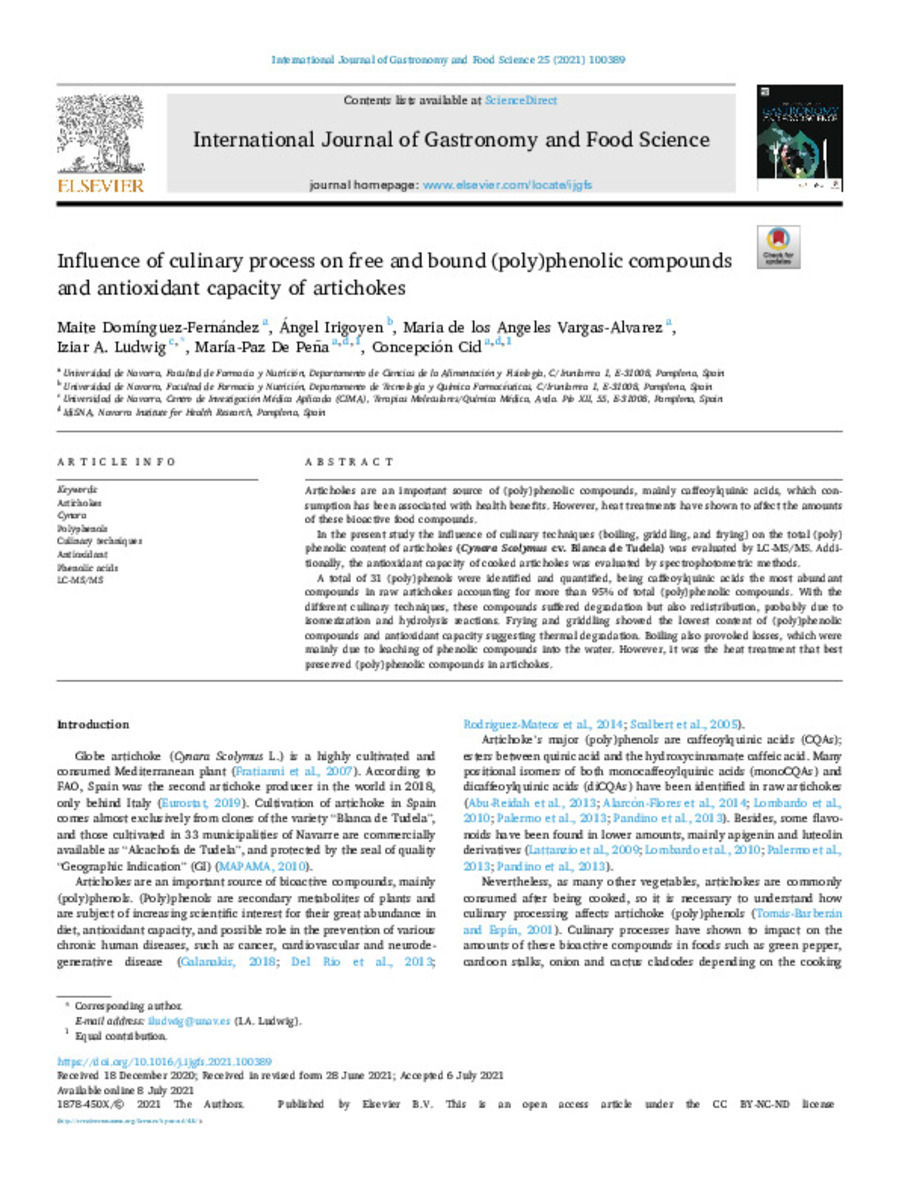Registro completo de metadatos
| Campo DC | Valor | Lengua/Idioma |
|---|---|---|
| dc.creator | Dominguez-Fernandez, M. (Maite) | - |
| dc.creator | Irigoyen, A. (Angel) | - |
| dc.creator | Vargas, A. (Angelina) | - |
| dc.creator | Ludwig, I.A. (Iziar Amaia) | - |
| dc.creator | De-Peña, M.P. (María Paz) | - |
| dc.creator | Cid, C. (Concepción) | - |
| dc.date.accessioned | 2022-04-06T09:12:48Z | - |
| dc.date.available | 2022-04-06T09:12:48Z | - |
| dc.date.issued | 2021 | - |
| dc.identifier.citation | Dominguez-Fernandez, M. (Maite); Irigoyen, A. (Angel); Vargas, A. (Angelina); et al. "Influence of culinary process on free and bound (poly)phenolic compounds and antioxidant capacity of artichoke". International Journal of Gastronomy and Food Science. (25), 2021, 100389 | es |
| dc.identifier.issn | 1878-450X | - |
| dc.identifier.uri | https://hdl.handle.net/10171/63357 | - |
| dc.description.abstract | Artichokes are an important source of (poly)phenolic compounds, mainly caffeoylquinic acids, which consumption has been associated with health benefits. However, heat treatments have shown to affect the amounts of these bioactive food compounds. In the present study the influence of culinary techniques (boiling, griddling, and frying) on the total (poly)phenolic content of artichokes (Cynara Scolymus cv. Blanca de Tudela) was evaluated by LC-MS/MS. Additionally, the antioxidant capacity of cooked artichokes was evaluated by spectrophotometric methods. A total of 31 (poly)phenols were identified and quantified, being caffeoylquinic acids the most abundant compounds in raw artichokes accounting for more than 95% of total (poly)phenolic compounds. With the different culinary techniques, these compounds suffered degradation but also redistribution, probably due to isomerization and hydrolysis reactions. Frying and griddling showed the lowest content of (poly)phenolic compounds and antioxidant capacity suggesting thermal degradation. Boiling also provoked losses, which were mainly due to leaching of phenolic compounds into the water. However, it was the heat treatment that best preserved (poly)phenolic compounds in artichokes. | es_ES |
| dc.description.sponsorship | We thank the Spanish Ministry of Science and Innovation (AGL2014-52636-P) and Plan de Investigación de la Universidad de Navarra, PIUNA (2018–09) for the financial support. M. Domínguez expresses her gratitude to Dept. of Education of the Government of Navarra (944/2016) and to the Spanish Ministry of Education (FPU16/03280) for the grants received. | es_ES |
| dc.language.iso | eng | es_ES |
| dc.publisher | Elsevier | es_ES |
| dc.rights | info:eu-repo/semantics/openAccess | es_ES |
| dc.subject | Artichokes | es_ES |
| dc.subject | Cynara | es_ES |
| dc.subject | Polyphenols | es_ES |
| dc.subject | Culinary techniques | es_ES |
| dc.subject | Antioxidant | es_ES |
| dc.subject | Phenolic acids | es_ES |
| dc.subject | LC-MS/MS | es_ES |
| dc.title | Influence of culinary process on free and bound (poly)phenolic compounds and antioxidant capacity of artichoke | es_ES |
| dc.type | info:eu-repo/semantics/article | es_ES |
| dc.description.note | This is an open access article under the CC BY-NC-ND license | es_ES |
| dc.identifier.doi | 10.1016/j.ijgfs.2021.100389 | - |
| dadun.citation.number | 25 | es_ES |
| dadun.citation.publicationName | International Journal of Gastronomy and Food Science | es_ES |
| dadun.citation.startingPage | 100389 | es_ES |
Ficheros en este ítem:
Estadísticas e impacto
Los ítems de Dadun están protegidos por copyright, con todos los derechos reservados, a menos que se indique lo contrario.






